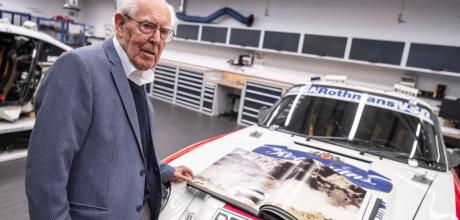Porsche engineer, Peter Falk, celebrates ninetieth birthday
Peter Falk very much prefers to stand behind his team rather than in the spotlight — the former racing director and engineer who worked for Porsche in Stuttgart for more than three decades is famously modest. “I’ve always said I don’t count at all, but my team has to be good. That’s the most important thing.” Just as this issue of 911 & Porsche World went to press, he celebrated his ninetieth birthday.
“We extend our warmest congratulations to Peter Falk and thank him for his tireless work for the Porsche brand,” says Michael Steiner, Member of the Executive Board for Research and Development at Porsche AG. “He played a leading role in the development of legendary sports cars, not least the 917. As racing director, our jubilarian was also responsible for the great success of the 956 and 962 in Group C, which is currently celebrating its fortieth anniversary.”
FALK DEVELOPED THE FOUR-WHEEL DRIVE VARIANT OF THE CARRERA 3.2 FOR THE PARIS-DAKAR
The son of an archaeologist, Falk was born in Athens on 27th November 1932. After an apprenticeship as a mechanic, he studied mechanical engineering, specialising in automotive technology. “From early childhood, I was interested in all forms of motion on land, from tricycles to bicycles to cars. Little wonder I made my intense interest in the technology used for these vehicles into my career.” When he was barely eighteen years old, he finished third in a motorbike precision driving contest in the Northern Black Forest. Six years later, he was seated alongside Alfred Kling in a rally-ready 356. Together, they proved victorious in their class. Then came victories in the 1957 Geneva Rally and the same year’s International German Rally, along with sixth place in the highly anticipated Liège-Brescia-Liège road race. In 1959, Falk joined Porsche as an engineer. He was one of only ten employees in the test driving department. Five years later, he started working in pre-series and racing support, where he was instrumental in getting the 911 on the track. At the 1965 Monte Carlo Rally, he was co-pilot to Herbert Linge in the two-litre 911. “I spoke into a thick plastic tube that went straight into Herbert’s helmet,” Falk recalls of the intercom system he developed. The pair finished fifth overall.
In the following years, many successful Porsche competition machines — from the 906 to the 917 — were built under the aegis of Falk as head of Porsche’s pre-series and racing department, allowing the sports car manufacturer to make a name for itself in the top class of international motorsport. From 1973 to 1981, Falk was test manager in the development of the 911, 924 and 928 series. Specifically, he was responsible for each model’s body, gearbox and road testing. Together with star technician, Roland Kussmaul, Falk developed the four-wheel drive variant of the Carrera 3.2 for the Paris-Dakar Rally in less than a year. And with success, too — this was the first time a sports car had won the toughest long-distance race in the world. From 1989 on, Falk was head of chassis development and oversaw pre-development and series development of the 993 and 996 generations of the 911, as well as the 986 Boxster. Make no mistake, this engineering legend is one of the people on whom the Porsche legend was built.


